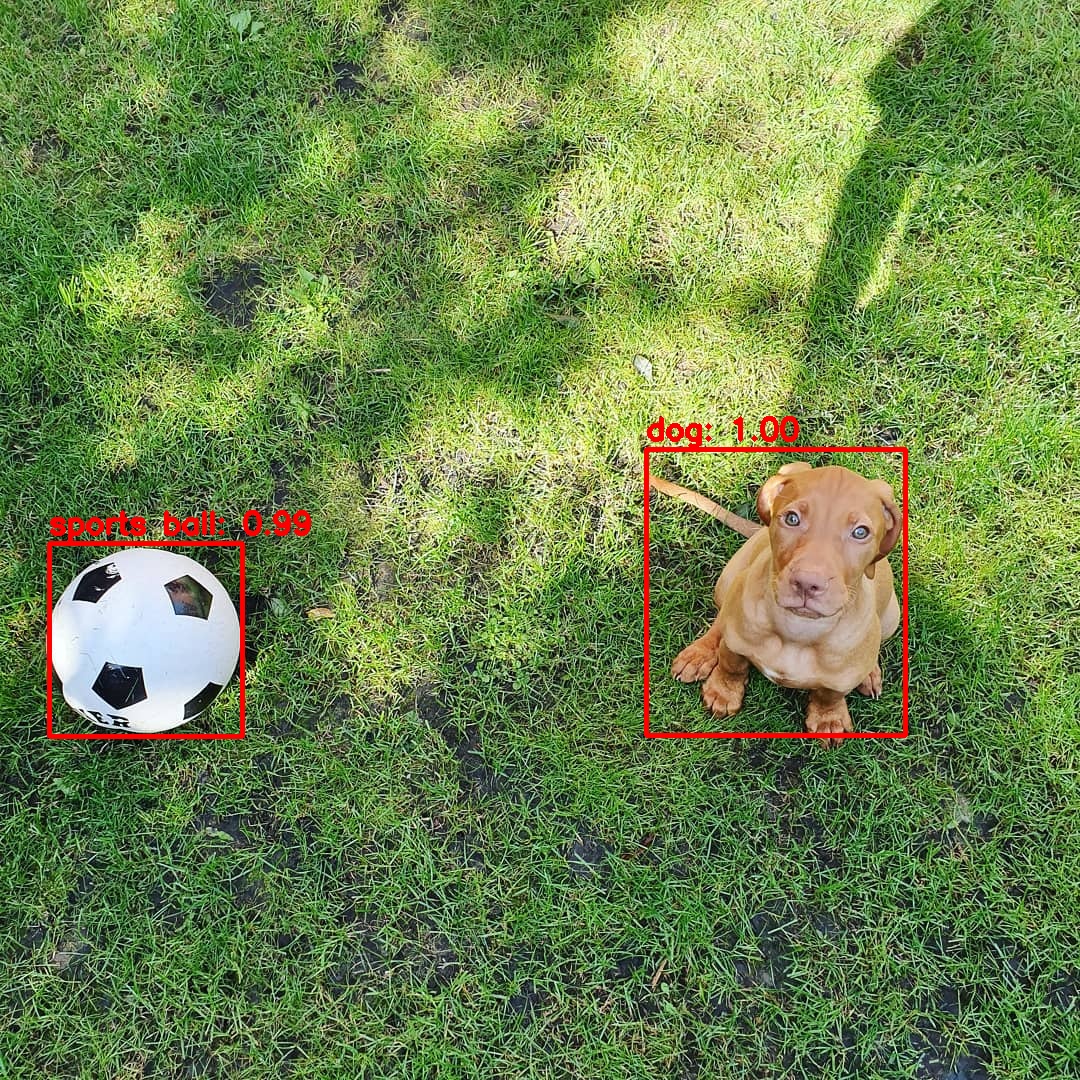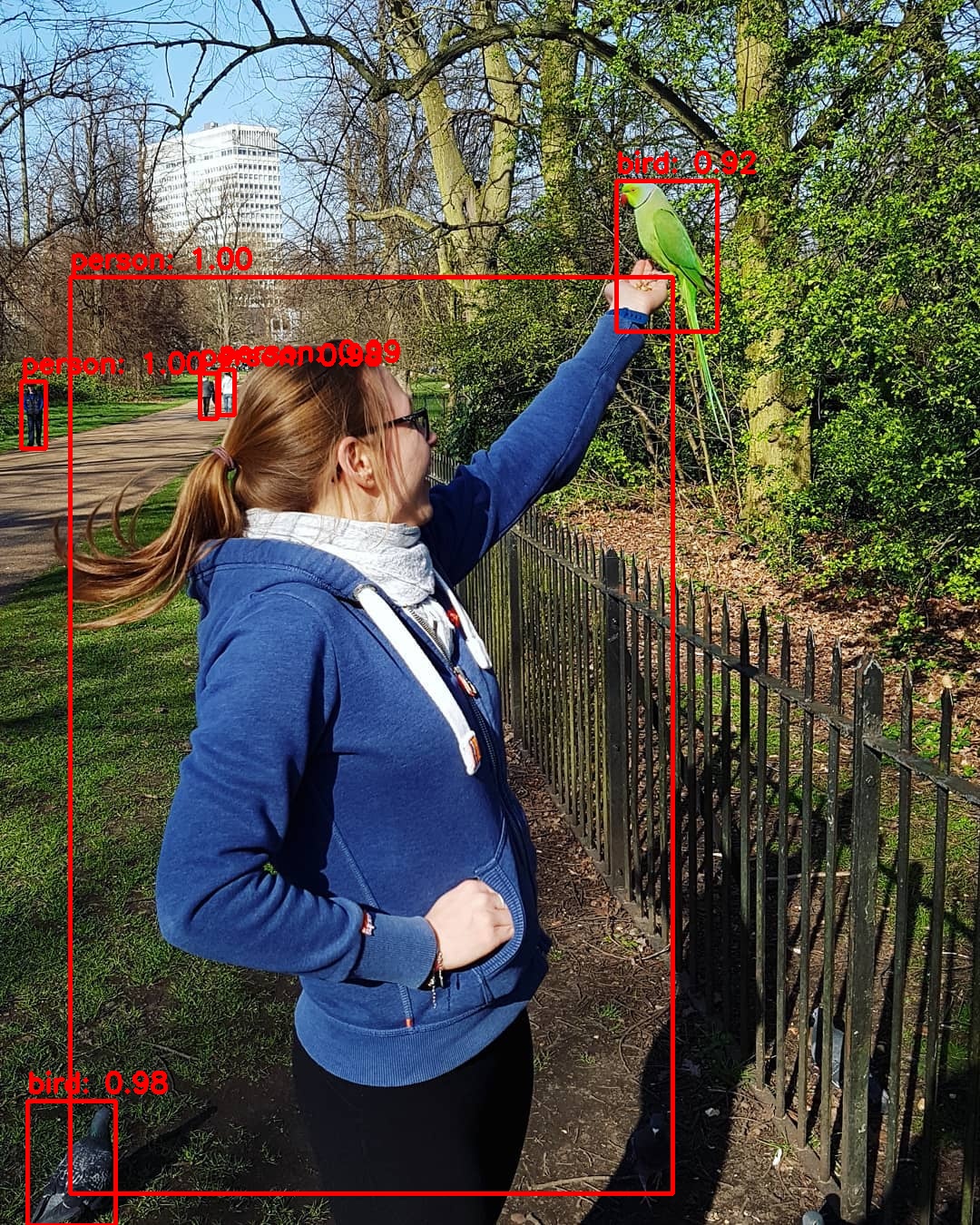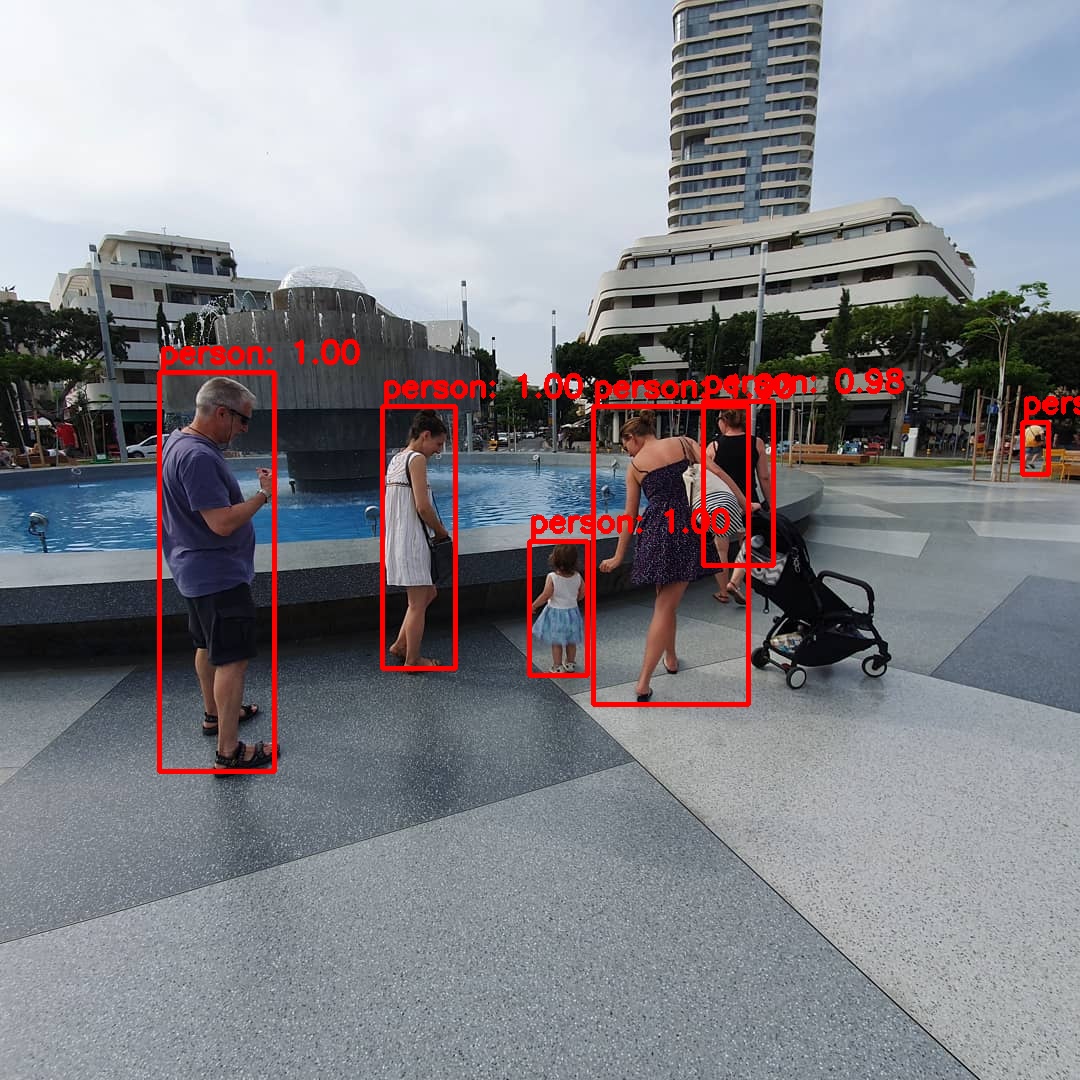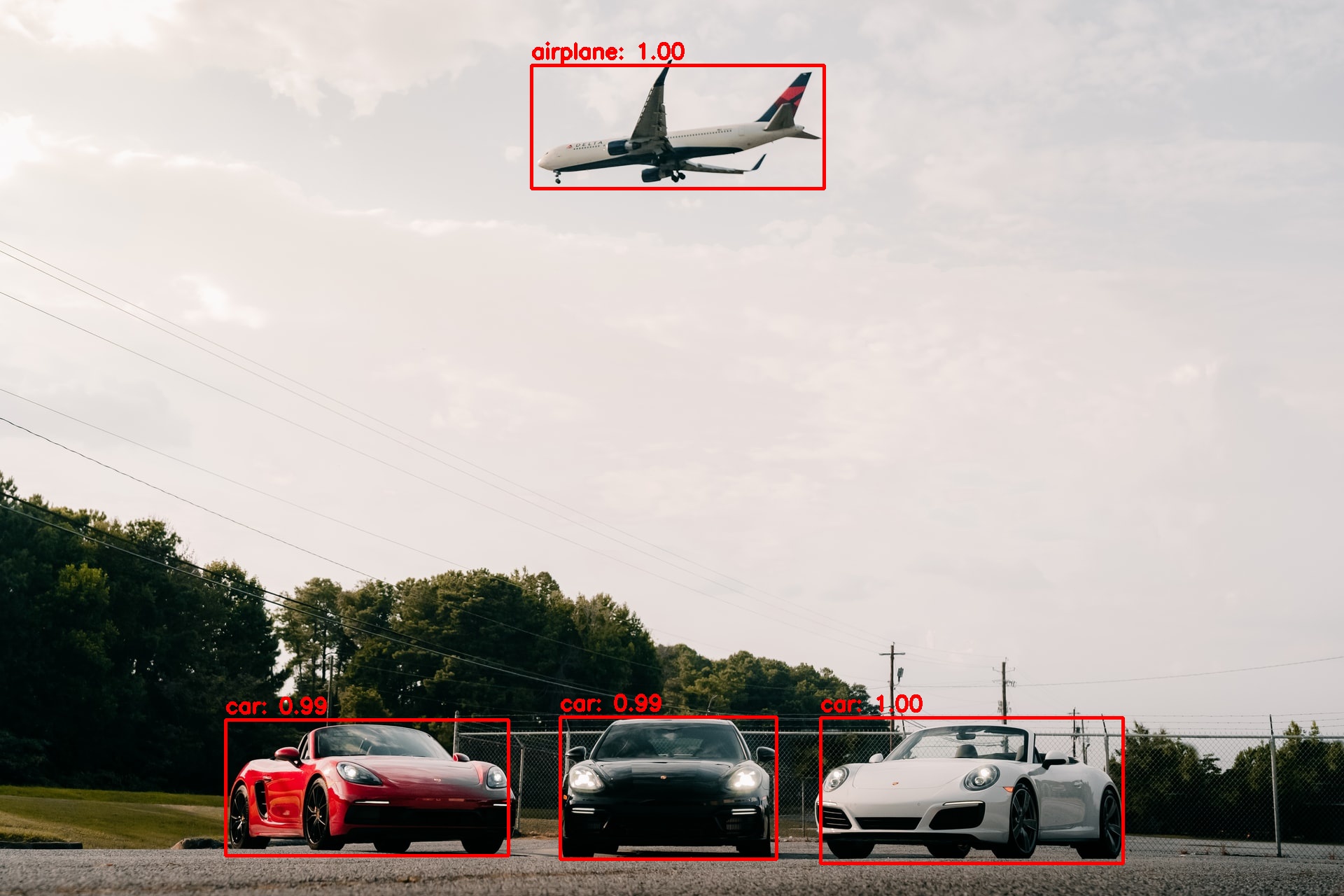Object Detection
One of the algorithms for object detection in images is called Faster R-CNN [paper].
Unlike the typical image classification task, which given an input image returns a class. The task of object detection is much harder, and many clever techniques have been developed to solve this task.
The objective is to be able to both provide a bounding box indicating indicating where an object is, as well as the class of that object. Therefore, the network combines both a classification task for the object class as well as a regression task for the bounding box coordinates. A key idea with the bounding boxes, is that they are not regressed from scratch, rather the regression adjusts a number of initial reference boxes (specifically 9 anchor boxes), which is easier.
The common idea is still to use a CNN to obtain feature maps at different scales, i.e. different network depths, as this contain encoded information within each neuron’s receptive field (the portion of the original image it “sees”), and the deeper the layer the larger the receptive field and the complexity of the features.
The feature map is used to propose potential regions of object, the proposed region is further fed into two separate fully-connected layers performing the classification and regression tasks.
There are plenty more specific implementation details as can be read in the paper, but that’s the idea.
Here I wanted to try out the pre-trained model using PyTorch.
The Google Colab notebook can be found here.
To see the allocated GPU specs:
!nvidia-smi
+-----------------------------------------------------------------------------+
| NVIDIA-SMI 450.66 Driver Version: 418.67 CUDA Version: 10.1 |
|-------------------------------+----------------------+----------------------+
| GPU Name Persistence-M| Bus-Id Disp.A | Volatile Uncorr. ECC |
| Fan Temp Perf Pwr:Usage/Cap| Memory-Usage | GPU-Util Compute M. |
| | | MIG M. |
|===============================+======================+======================|
| 0 Tesla P100-PCIE... Off | 00000000:00:04.0 Off | 0 |
| N/A 49C P0 36W / 250W | 4020MiB / 16280MiB | 0% Default |
| | | ERR! |
+-------------------------------+----------------------+----------------------+
+-----------------------------------------------------------------------------+
| Processes: |
| GPU GI CI PID Type Process name GPU Memory |
| ID ID Usage |
|=============================================================================|
| No running processes found |
+-----------------------------------------------------------------------------+
Which is the: Tesla P100 PCIe 16 GB.
The code
Imports:
import torch
from torchvision.models.detection import fasterrcnn_resnet50_fpn
import torchvision.transforms as T
import numpy as np
from PIL import Image
import cv2
import matplotlib.pyplot as plt
Load pre-trained Faster R-CNN model and move to GPU if exists. The ResNet50 indicates that the backbone of the network used for the feature map generation is the ResNet50 CNN.
device = torch.device('cuda' if torch.cuda.is_available() else "cpu")
model = fasterrcnn_resnet50_fpn(pretrained=True).to(device)
# Set model to evaluation mode (need for dropout and batchnorm which work differently under training and evaluation)
model.eval()
The model was originally trained on an object detection dataset called COCO (Common Objects in Context), which has 90 classes (not including background class, i.e. no object).
# Predefined object classes
COCO_CATEGORIES = [
'__background__', 'person', 'bicycle', 'car', 'motorcycle', 'airplane', 'bus',
'train', 'truck', 'boat', 'traffic light', 'fire hydrant', 'N/A', 'stop sign',
'parking meter', 'bench', 'bird', 'cat', 'dog', 'horse', 'sheep', 'cow',
'elephant', 'bear', 'zebra', 'giraffe', 'N/A', 'backpack', 'umbrella', 'N/A', 'N/A',
'handbag', 'tie', 'suitcase', 'frisbee', 'skis', 'snowboard', 'sports ball',
'kite', 'baseball bat', 'baseball glove', 'skateboard', 'surfboard', 'tennis racket',
'bottle', 'N/A', 'wine glass', 'cup', 'fork', 'knife', 'spoon', 'bowl',
'banana', 'apple', 'sandwich', 'orange', 'broccoli', 'carrot', 'hot dog', 'pizza',
'donut', 'cake', 'chair', 'couch', 'potted plant', 'bed', 'N/A', 'dining table',
'N/A', 'N/A', 'toilet', 'N/A', 'tv', 'laptop', 'mouse', 'remote', 'keyboard', 'cell phone',
'microwave', 'oven', 'toaster', 'sink', 'refrigerator', 'N/A', 'book',
'clock', 'vase', 'scissors', 'teddy bear', 'hair drier', 'toothbrush'
]
The model’s output looks as follows for a sample image:
# Example output
img = Image.open('dog_ball.jpg')
transform = T.Compose([T.ToTensor()])
img = transform(img)
out = model([img])
out
Output:
[{'boxes': tensor([[646.0035, 449.6353, 905.4247, 735.7059],
[ 49.0856, 543.5223, 242.2890, 736.4569],
[164.4843, 577.5748, 204.7126, 619.7700]], grad_fn=<StackBackward>),
'labels': tensor([18, 37, 1]),
'scores': tensor([0.9989, 0.9896, 0.2459], grad_fn=<IndexBackward>)}]
It is a list of dictionaries (one dictionary per input image). The output contains three keys: boxes, labels and scores with tensor values. The boxes contains the identified boxes as a tensor with 4 values per box corresponding to the top left and bottom right corners. The labels contain the identified classes (one per box). The scores contain the probability of the classification, which is binary, either the object belongs to the class or not.
The detection function:
def detect(img_path, save_path, threshold=0.9):
"""
Use Faster R-CNN to detect objects in an image.
Filter objects with score below threshold
"""
# Load image
img = Image.open(img_path)
# Convert to tensor and move to device
transform = T.Compose([T.ToTensor()])
img = transform(img).to(device)
# Input image to model and get output, expects list of images
out = model([img])
# Get class scores and filter above a threshold
# Note we need to detach the object, before moving it to cpu, because it is part of the computation graph.
# Same applies for the detaches below
# Alternatively is to do `with torch.no_grad():` to disable following operations on the object
indxs = np.where(out[0]['scores'].detach().cpu().numpy() >= threshold)[0]
# Get detected classes labels
detected_classes = [COCO_CATEGORIES[i]
for i in out[0]['labels'].detach().cpu().numpy()[indxs]]
# Get scores (not used, but can be added to the image)
scores = [out[0]['scores'].detach().cpu().numpy()[i] for i in indxs]
# Get the boxes corresponding to detected objects as numpy arrays
boxes = [out[0]['boxes'].detach().cpu().numpy()[i] for i in indxs]
# Create rectangles in the format OpenCV expects, two tuples of top left
# and top right corners
rects = [[(box[0],box[1]), (box[2], box[3])] for box in boxes]
# Use OpenCV to draw rectangle and text on image
img = cv2.imread(img_path)
# Need to convert from BGR to RGB
img = cv2.cvtColor(img, cv2.COLOR_BGR2RGB);
# Loop over bounding boxes and class and add to the image
for rect, dclass, score in zip(rects, detected_classes, scores):
x, y = rect[0]
# Draw Rectangle with the coordinates
cv2.rectangle(img,
rect[0],
rect[1],
color=(255, 0, 0),
thickness=3);
# Add the class label to the image as text
cv2.putText(img,
f"{dclass}: {score:.2f}",
(int(x), int(y)-10), # shift text vertically from box
cv2.FONT_HERSHEY_SIMPLEX,
1,
(250,0,0),
thickness=4);
# Show image
plt.imshow(img)
# Save image
# OpenCV expects BGR to save properly
img = cv2.cvtColor(img, cv2.COLOR_RGB2BGR);
cv2.imwrite(save_path, img)
Examples
(The function call for the below examples below examples takes ~0.2 second per image):


I actually didn’t see the bird at the lower left corner before!

Little people are correctly identified.
 Photo by Joe Yates on Unsplash
Photo by Joe Yates on Unsplash
The next step would be to utilize the pre-trained model (transfer learning) to detect new classes of objects.